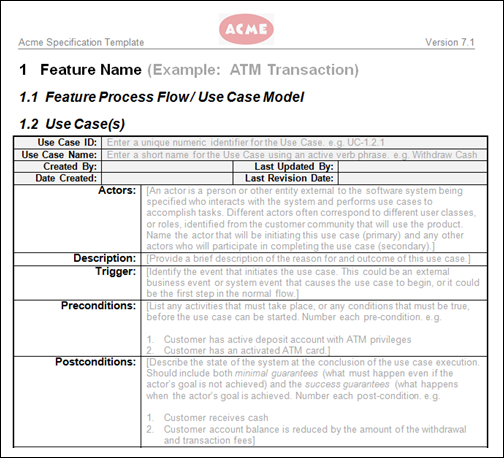Add project branding to generated documents
Valid from Pega Version 7.1.7
The standard Word Template for specification descriptions is now extensible. Using a customized template allows you to brand your generated documents with project-specific elements.
Specialize the Rule-Application-UseCase.pySpecificationDescription rule to:
- Include relevant images such as company logos.
- Define static text.
- Insert dynamic elements by merging clipboard values into field codes.

Generated document with custom company logo
Refer to Advanced options for editing specifications for instructions on how to override this template.
Third party models integration made possible by directly importing PMML in predictive models
Valid from Pega Version 7.1.7
Predictive models can now import models in PMML format. The PMML integration in predictive models allows you to use third party models without extra conversion and configuration. For more information on this new feature, see About Predictive Model rules.
Improved adaptive model accuracy
Valid from Pega Version 7.1.7
Enhancements have been made in the grouping scores method that is used to create the adaptive model outcome profile (also known as: classifier). Because scores form the base for calculating propensities, these changes make models more accurate. The enhanced grouping scores method is available with any new model generated in Pega 7.1.7 and does not require any changes to existing adaptive model rules or adaptive model components. For more information on adaptive models, see About Adaptive Model rules.
New Cassandra connector rules allow applications to use data in BigData stores
Valid from Pega Version 7.1.7
The new Connect Cassandra rule type provides the interface to leverage data in Cassandra data stores. This means that your applications can use large data sets stored in Cassandra data stores. For more information on this connector type, see About Connect Cassandra rules.
In-memory Adaptive Analytics Manager process
Valid from Pega Version 7.1.7
The new internal Adaptive Analytics Manager (ADM) process running in PRPC makes it possible to use adaptive analytics without the availability of the external ADM server. Although not a replacement for the external ADM server, it streamlines the design and development of applications making use of adaptive analytics. For more information on the configuration that allows your application to use the internal ADM process, see the Infrastructure Services landing page.
New Hbase connector rules allow applications to use data in BigData stores
Valid from Pega Version 7.1.7
The new Connect HBase rule type provides the interface to leverage data in HBase data stores. This means that your applications can use large data sets stored in HBase data stores. For more information on this new rule type, see About Connect HBase rules.
Delayed adaptive learning
Valid from Pega Version 7.1.7
Data flows, a new rule type in Pega 7.1.7, allow you to store adaptive inputs and interaction results for a given period of time when running a strategy. This makes it possible to capture and learn from responses at a later date. For more information on data flow design for delayed learning, see Data Flow rule form - Completing the Data Flow tab.
Decision data stores
Valid from Pega Version 7.1.7
Decision Management in Pega 7.1.7 introduces two new concepts to manage data: decision data stores, and Data Nodes (DNodes). Horizontally scalable, and supported by DNodes, decision data stores take data from different sources, and make it available for real time and batch processing. This infrastructure is managed through the DNode Cluster Management landing page.
Your application can be a SAML service provider
Valid from Pega Version 7.1.7
You can quickly establish your application as a SAML service provider, with a web SSO profile, SOAP binding, and HTTP redirect binding to support single logout binding. The service is interoperable with Ping Identity, Tivoli Federated Identity Manager, and many other leading identity service providers (ISPs).
Manage data from different sources using data sets
Valid from Pega Version 7.1.7
Data sets define collections of records, allowing you to set up instances that make use of data abstraction to represent information stored in different sources and formats. This new rule type introduces the ability to manage data in database tables, decision data stores, and Visual Business Director data sources. Standard Interaction History and Adaptive Manager data sets manage interaction results and adaptive model data. The DataSet-Execute method supports data management operations on records that are defined by the data set. For more information on this new rule type, see About Data Set rules.

